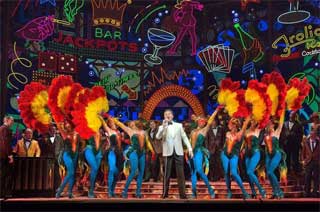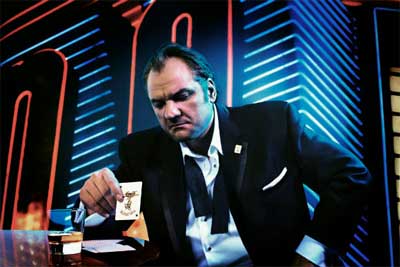Opera (1851)
by Giuseppi Verdi
Libretto by Francesco Maria Piave
Based on the play Le roi s’amuse (The King Amuses Himself)
by Victor Hugo.
Metropolitan Opera
New York, NY
Live in HD
Conductor: Michele Mariotti
Production: Michael Mayer
Set Designer: Christine Jones
Costume Designer Susan Hilferty
Lighting Designer: Kevin Adams
Choreographer: Steven Hoggett
With Diana Damrau (Gilda), Oksana Volkova (Maddalena), Piotr Beczala (The Duke), Željko Lučić (Rigoletto), Štefan Kocán (Sparafucile)

and Company
in “Rigoletto”
Photo: Ken Howard/Metropolitan Opera
Rigoletto is the court jester for The Duke, who is an incurable womanizer, and partakes in various ruses sponsored by The Duke’s cronies to enable his escapades. Unbeknownst to Rigoletto, his beautiful and innocent daughter, Gilda, has fallen for The Duke without knowing who he is. Thinking he is a poor student, her heart is stolen, and big trouble begins. Caught red-handed in some of his acts as The Duke’s crony, Rigoletto is cursed by one of the cuckolds, foreboding ill. Once Rigoletto finds out about The Duke’s pursuit of Gilda he is none too pleased, and things get complicated when Rigoletto seeks revenge and hires Sparafucile, an assassin. However much he tries to frustrate The Duke’s pursuit of Gilda, the curse bears potency, and tragedy ensues.
This delightful new production is set in Las Vegas in the 1960s and has lots of neon and glitz. The idea of this narcissistic and corrupt setting is well suited to the opera, all about an irresponsibly indulgent royal. The sets, lighting and costumes are beautifully conceived overall and makes the whole experience lots of fun.
The male chorus, all decked out in its snazzy Las Vegas wares, looked great, and the Peter Lawford, Sammy Davis and Dean Martin act-alikes were all very good.

in “Rigoletto”
©2012 Metropolitan Opera
In his entr’acte interview with noted soprano Renée Fleming, the very capable Rigoletto, Željko Lučić, said, quite humorously, that he was told, presumably by the director, that his character was like Don Rickles. It is quite funny to think of this international opera star even coming to know who Don Rickles is, much less using his persona as the basis of his characterization. But that is just one of the curiosities that make this production vivacious and interesting.
It is something of a gamble to redesign these classic productions, and sometimes it just does not work. Last season’s new, abstractionist production at the Metropolitan Opera of La Traviata I thought not successful. Its austerity and overwrought symbolism just did not come across to me.
But here the glitz and the glamour fit right in.
Even the act opening which (Holy Cow, at the Metropolitan Opera!) features a nearly nude pole dancer, in pasties, doing her salaciously seductive dance, works, and is a convincing piece of the action.
The direction and the design team of Michael Mayer, Christine Jones, Susan Hilferty and Kevin Adams have come off a number of recent Broadway successes (the celebrated rock musical, Spring Awakening, on Broadway from 2006 to 2009, among them) and the embellishment and inventiveness they offer here is very welcome.
In general the singing was very good.
It was, I must say, ironic to listen to the range of interviews with the principal singers conducted by Fleming, who asked repeatedly about the influence of the distinctive new production on their performances, only to hear repeatedly that it did not make very much of a difference. Though they acknowledged the ingenuity and guidance of the adept director, Michael Mayer, in helping them to develop these Rat Pack inspired characters, they generally seemed to regard the unique production values as insignificant to the major dramatic thrust of the opera and to their performances.
Diana Damrau (Gilda) has a beautifully clear soprano and a capacity to shape and project phrases with great care and specificity. Her vocal talents were much on show in this virtuosic role. However, her acting did not quite do it for me, her character coming across too much like a wholesome milkmaid rather than like the child of a Las Vegas comedian, however pure of heart.
Piotr Beczala (The Duke) did his vocal job adeptly, and carried off the role of the irresponsible lord gleefully. He finished his great aria, La Donna è Mobile swinging with abandon around the pastied dancer’s pole.
Željko Lučić, as Rigoletto, bore his role with a convincing mood of burden and doom, dragging himself portentously around stage, crying out with a voice richly seasoned with gravel, as well as gravity, making the entire portrayal darkly forceful.
The most distinctive voice, however, was that of Štefan Kocán, in the relatively small role of Sparafucile, the assassin. His rich bass projected and echoed, and his depiction of the dastardly murderer was impeccably unsettling. The audience cheered for him.
The design of the final act involves a pervasive and inventive use of neon, putting Las Vegas on an especially high dose of drugs, bringing it to the intoxicating levels of grand tragic opera.
The conductor, Michele Mariotti, looked very young, more from the Brat Pack than the Rat Pack (though actually older than he appeared, at about 33), but he carried off his duties very well.
– BADMan
Leave a Reply